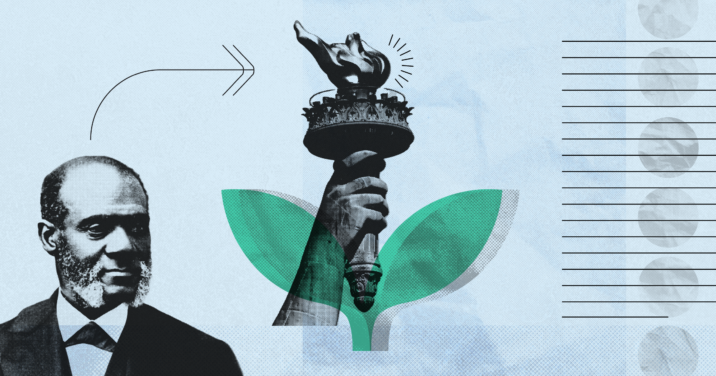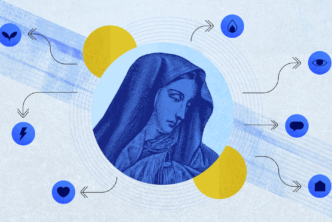So, you’ve read about Charles Spurgeon and Roger Williams, and maybe you even know a good deal about Black theologians like Martin Luther King Jr. or C. T. Vivian. But just as Church history didn’t start at the Reformation, the history of the Black church didn’t start during the civil rights movement.
Knowing the history of the Black church is essential because it’s family history. Black history isn’t merely a recap of the past or rehashing of past sins. Rather, Black history—and all history—offers us wisdom for our past, present, and future. I would encourage you to consider history with these three analogies:
- A journal revealing where we’ve been and how we arrived at today
- A coach that teaches us love and compassion for one another
- A map that helps us end patterns of sin in our past by showing us where we’re going together
While the Church is not yet what we will be (1 John 3:1–3), God is making us one in love (Eph 4:11–16) and worship (Rev 7:9–10). We will one day stand in front of God’s throne fully united and at the same time fully ourselves—“every nation, tribe, people, and language” (Rev 7:9 CSB).
Our future reality is just that—future. But Scripture teaches us to pray and work to reflect God’s already-and-not-yet kingdom in our world (Matt 6:10). Growing together as one body of Christ requires growing in love and understanding—in short, knowing all of our history, including Black history.
This year, look back at our history by learning about these six Black theologians, pastors, and missionaries who were influential in American and Christian history.
***
George Liele
“George Liele . . . was converted through the witness of his master. He was a subscriber to the Reformed faith, he was a gifted preacher, and he was free to carry on his work. Between 1773 and 1775, he established the Silver Bluff Church, and it was located on the South Carolina bank of the Savannah River near Augusta, Georgia.
“Now, in about 1782, George Liele baptized a young man named Andrew Bryan, who went on to found the African Baptist Church in Savannah, Georgia—and by the way, this is the oldest existing Black church in the country, and it is still there; you can go to Savannah and take pictures of it. Liele became the undisputed leader of African American Christians in Georgia until 1783. . . .
“In 1783 George Liele immigrated to Jamaica. As a Black, itinerant, ex-slave preacher, he was indeed a novelty on the whole island. And, therefore, he attracted considerable attention, and news of his preaching quickly spread. His preaching style was similar to that of Whitefield—very powerful orator, very powerful orator. Well, he was instrumental in planting hundreds of churches throughout the Caribbean. George Liele is a well-known figure in the Caribbean, and he is greatly revered. He was America’s first missionary—an African American—and he’s often forgotten in our history, but that’s what it was.”1
Rev. Henry Highland Garnet
“Rev. Henry Highland Garnet . . . was born a slave in Kent County, Maryland; he escaped from slavery in 1824; he studied theology at Oneida Institute in Utica, New York; and became a pastor. Later he served as the president of Avery College in Allegheny, Pennsylvania.
“He expressed some of his thoughts in his address to the National Convention of Colored Citizens in Buffalo, New York in August of 1843—and remember, this was 1843. This is essentially what he said (and I’m taking excerpts from the speech):
In every man’s mind the good seeds of liberty are planted, and he who brings his fellow down so low, as to make him contented with a condition of slavery, commits the highest crime against God and man. . . .
To such degradation, it is sinful in the extreme for you to make voluntary submission. The divine [command] you are in duty bound to reverence and obey. [And] if you do not obey them, you will surely meet with the displeasure of the Almighty.…
Your condition does not absolve you from your moral obligation. The diabolical injustice by which your liberties [have been] cloven down, neither God, nor angels, or just men, command you to suffer for a single moment. Therefore it is your … duty to use every means, both moral, intellectual, and physical, that [promotes] success. . . .
Brethren, arise!… [And] strike for your … liberties. Now is the day and the hour. Let every slave throughout the land do this and the days of slavery are numbered. You cannot be more oppressed than you have been—you cannot suffer greater cruelties than you have already. Rather die [as] freemen than [to] live [as] slaves. . . .
Let your motto be resistance! Resistance!! Resistance!!! No oppressed people have ever secured their liberty without resistance.
“That’s a remarkable statement. Here’s a man who was a Presbyterian, and yet, he sees the implications of what the Bible says: that slavery is not compatible with being a human being. Now, he was not advocating violence, but it’s interesting in his statement—a lot of people give Malcolm X credit for saying, ‘We want liberty in this land at this time, by any means necessary,’ but 120 years before he said that, Henry Highland Garnet says something even more powerful. He was one of these thinkers who traveled and was one of those involved in this transnational Black community.”2
Rev. Alexander Crummell
“Another one that you may have heard of or may not have was Rev. Alexander Crummell. He emerged in the late 1850s. He was the first president of the American Negro Academy. He mentored none other than W. E. B. DuBois. If you’ve heard of DuBois and if you’ve read any of his things, then you have seen some of Crummell’s ideas. It was Crummell who gave DuBois the idea of developing the talented tenth to lead our people.
Economic development
“What Crummell emphasized was the need for economic development in Africa and the need for Africa’s descendants around the world to develop economic ties with the motherland. This is what he believed: he said [that] strong economic ties with Africa will lead to the development of Negro commercial power in Africa and in other lands where people of African descent live. The prosperity of Africa could be assured if the natural resources and wealth of Africa were properly developed. And this is what he was saying: He was saying, ‘Not only do we need to bring evangelism and all the rest of that, but we must work together to empower the people we bring the gospel to develop economically and to begin to be empowered.’
Theology of empowerment
“Remember, they carried, over to the continent, this theology of empowerment. He went on to say that, if Africa and her transplanted descendants could gain control of that development and the resulting benefits, then things would be rapidly improved—we can reach the whole continent for Christ. The God-given mission of the African Americans—or, as they said, the American Negro—was to rescue Africa from ruin, to empower the oppressed people of African descent, and, as he put it, to ‘destroy the power of the devil in his strongholds’ by ushering in light, knowledge, hope, and Christian faith.
The AME Church
“Crummell was aware of the presence of Islam in Africa; he was also aware of the Arabization of some of the tribes there, and he was also aware of the fact that the whole system of slavery was introduced largely, and exploited, by Arabs and Muslims. So, he pointed, then—he pointed to the ministry of the AME Church as proof that African Americans were up to the task. The AME Church had established home missions. They’d founded a college. And as a model of what Africans could do, he said the AME Church stands out. The AME Church, by this time, had the fourteenth and fifteenth Episcopal districts already established and functioning in western Africa and southern Africa.”3
Growing together as one body of Christ requires growing in love and understanding—in short, knowing all of our history, including Black history. Share on X
Richard Allen
“In 1781, (Richard) Allen began traveling the Methodist preaching circuits in Delaware and surrounding states. ‘My usual method was when I would get bare of clothes, to stop traveling and go to work,’ he said. ‘My hands administered to my necessities.’ Increasingly, prominent Methodist leaders, like Francis Asbury, made sure Allen had places to preach. In 1786 the former slave returned to Philadelphia and joined St. George’s Methodist Church. His leadership at prayer services attracted dozens of Blacks into the church, and with them came increased racial tension.
“By 1786 Blacks made up about 10 percent of the Methodist Church in the United States, and though whites and Blacks often worshiped together, Blacks enjoyed no real freedom or equality. Segregated seating was typical; the area reserved for Blacks was usually called the ‘Negro Pew’ or the ‘African Corner.’
“St. George’s had no history of segregated seating, at least until the later 1780s. Then white leaders required Black parishioners to use the chairs around the walls rather than the pews. During one service in 1787, a group of Black (people) sat in some new pews that, unbeknownst to them, had been reserved for whites. As these Black (men) knelt in prayer, a white trustee came over and grabbed Absalom Jones, Allen’s associate, and began pulling on him, saying, ‘You must get up—you must not kneel here.’
“Jones asked him to wait until prayer was over, but the trustee retorted, ‘No, you must get up now, or I will call for aid and force you away.’ But the group finished praying before they got up and walked out.
“Allen had for some time thought of establishing an independent Black congregation, and this incident pushed him over the edge. Nonetheless, he had no desire to leave Methodism or the local Conference: ‘I was confident,’ he later wrote, ‘that there was no religious sect or denomination would suit the capacity of the colored people as well as the Methodist; for the plain and simple gospel suits best for any people.’ Still, he recognized that Blacks needed a place they could worship in freedom.
“Though Methodist leaders resisted Allen and Jones, threatening them with expulsion from the Methodist Conference (while at the same time pleading for their help during the 1793 epidemic), Allen went ahead and, in 1794, purchased an old frame building, formerly a blacksmith’s shop, and created the Bethel African Methodist Episcopal Church. Bishop Francis Asbury dedicated the building and, in 1799, ordained Allen as a deacon.
“For the next 15 years, white Methodist leaders in Philadelphia tried to keep Allen’s congregation and property under its jurisdiction. But on the first day of 1816, the Pennsylvania Supreme Court ruled that the church belonged to Allen and his associates.
“A denomination quickly came together. In April, delegates from several Black Methodist churches convened in Philadelphia and drew up an ‘Ecclesiastical Compact’ that united them in the independent African Methodist Episcopal Church (AME). Allen was ordained an elder and then consecrated as bishop—the first black to hold such an office in America.
“Blacks in Baltimore, Wilmington, Attleboro, and Salem followed Allen’s example and established independent African Methodist churches. Allen oversaw the rapid growth of the AME’s mother church in Philadelphia, which grew to 7,500 members in the 1820s. The denomination became by all accounts the most significant Black institution in the nineteenth century, and today has over 6,000 churches and over 2 million members.”4
C. P. Jones
“A young man from Mississippi became a key leader in [the Holiness Church] movement, and his name was Charles Price Jones, or better known as C. P. Jones. In 1895 he pastored the Mount Helm Baptist Church. Now, the church came out of another church called First Baptist Church in Jackson, Mississippi. First Baptist Church—now, of course, you know, in many cities around the county you have two First Baptist churches oftentimes. There’s a white First Baptist and there’s a Black First Baptist—so, just First Baptist Church in Jackson.
“Before he came to Jackson, though, he also experienced what he called the ‘second work of grace,’ which is very much connected to the baptism of the Holy Spirit, except it wasn’t involved in speaking in tongues. There’s this concept of, you get saved and then you get sanctified as one thing, as opposed to sanctification being an ongoing process.
“In 1896, then, he accepted the Holiness doctrine and tried to lead his church into the deeper life—what he called the ‘deeper life in Christ.’ He tried to lead the church into more of the Holiness orientation. Now, C. P. Jones attracted many Baptists to his teachings, including many preachers. And among these preachers were people like W. S. Pleasant, J. A. Jeter, and another one that you’ve probably heard of, Charles Harrison Mason. C. H. Mason was a very, very key figure in twentieth-century African American church history. He was born in 1866, converted in 1880, licensed in the Missionary Baptist Church, and he experienced, again, the second work of grace in 1893.
Changing a name
“Now, C. P. Jones wanted to change the name of the church to the Church of Christ in order to exalt Jesus, but he got strong resistance. This issue was then taken to court, and Jones won in lower court, but he lost in the Mississippi Supreme Court. The case was decided on the basis of the conditions under which the land for the church was donated. The land for the Mount Helm Baptist Church was given to a man named W. C. Helm, and he was a Presbyterian. He donated the land to build this church. Of course, the church then was named Mount Helm. So, C. P. Jones lost the case in the higher court. C. P. Jones and C. H. Mason then left Helm Baptist Church and founded a new Holiness church in Lexington, Mississippi with converts from the revivals that they had been doing all over the place.
“Now, C. H. Mason then named this new church the Church of God in Christ, Church of God in Christ. C. P. Jones teamed up with C. H. Mason, and they began to lead revivals in Lexington and in Jackson and other areas. C. P. Jones and C. H. Mason were excluded from the Baptist Association because of their beliefs. In 1897 C. P. Jones continued—let me see, he decided to do some revivals around, and he conducted the first Holiness Convention in Jackson, Mississippi. In 1900 the name of the movement became the Christ Association of Mississippi Baptist Believers in Christ—the Christ Association of Mississippi Baptist Believers in Christ.
“In 1906 the name of the national movement became the Church of God in Christ. Here we begin the Church of God in Christ, which has become one of the strongest and largest denominations in the African American community in the twentieth century.
Baptism of the Holy Spirit
“Now, the Church of God in Christ then sent J. A. Jeter, C. H. Mason, and D. J. Young to investigate the Azusa Street Revival under the leadership of William Seymour. They all received Seymour’s doctrine of the baptism in the Holy Spirit, and in 1907 the Church of God in Christ became an official denomination. There was an extended discussion in this new denomination about the baptism in the Holy Spirit. Most in the Church of God in Christ rejected the doctrine of the baptism in the Holy Spirit. As a result, J. A. Jeter, C. H. Mason, and D. J. Young separated from C. P. Jones, and they started the Pentecostal wing of the Church of God in Christ. C. P. Jones assumed the leadership of the Holiness wing of the Church of God in Christ. And later, J. A. Jackson recanted his belief in the Pentecostal doctrine and rejoined C. P. Jones.
Growth of multiple denominations
“Now, C. H. Mason, then, was the first to incorporate the name Church of God in Christ as the name of the Pentecostal denomination, or the Pentecostal wing of the movement. This happened in 1915, and C. H. Mason became the first bishop. C. P. Jones then incorporated the name Church of Christ (Holiness) USA in 1920, and he became the first bishop. C. P. Jones died in 1949. And then, finally, by 1998, the denomination, the Church of Christ (Holiness), had grown to about 10,400 members with 167 congregations—mostly concentrated in the Mississippi area, but some up the East Coast, in Virginia and other places. And of course, the Church of God in Christ has grown to about seven or eight million in that time.”5
Charles Octavius Boothe
The following is excerpted from the introduction Walter R. Strickland II provided for Boothe’s book, Plain Theology for Plain People.
Charles Octavius Boothe (1845–1924) was a reluctant teacher. To spare others his frustration with learning and teaching from books laced with dense theological rhetoric, Boothe wrote Plain Theology for Plain People.6
Boothe wrote for the average sharecropper. He accommodated an unlearned audience that included pastors, teachers, and community leaders born into poverty with little access to education. While leaders and laity alike desperately needed biblical and theological truth, they had little time, energy, and resources to pursue education. “The doctrines of our holy religion need to be studied in order, according to some definite system,” he wrote, “but simplicity should prevail—simplicity of arrangement and simplicity of language.” Thus, Boothe set out to write a succinct and accessible theological handbook.7
Who was Charles Octavius Boothe?
On June 13, 1845, Charles Octavius Boothe was born in Mobile County, Alabama. He was the legal property of Nathaniel Howard.
As a slave he was treated relatively mildly. “I think I can say that [my master] and I really loved each other,” he wrote.8 Nevertheless, he was a frank critic of slavery. He indicted all white Americans for imposing barbarous conditions upon his people.9 Proponents of slavery argued that God used the practice to bring blacks to salvation; in contrast, Boothe contended that the gospel spread to slaves despite chains and oppression. “As for you, you meant evil against me; but God meant it for good, to bring it about that many people should be kept alive, as they are today.” (Gen 50:20 ESV). God takes no pleasure in the denial of his image; yet nothing prevents his will.10
Nearly four million slaves were freed by the Emancipation Proclamation in 1865. Still, blacks remained captive to social and economic norms that complicated daily life. Legislation did not eradicate four hundred years of white contempt. Former slaves had few skills, resources, and institutions to support themselves. Due to these economic challenges, sharecropping—freed slaves rented and tended part of a white farmer’s land in exchange for a variable percentage of its yield—became a common practice for blacks. They still lacked the means to be truly independent.
Racial uplift was Boothe’s consuming passion. Following the Civil War (1861–1865), he worked to improve the spiritual, social, and intellectual well-being of blacks in a society that denied their humanity before God and in its Constitution.11 Boothe focused on education because an educated black populace contradicted the notion among whites that blacks would regress into “savagery.”12
Boothe learned how to read at a young age. At the age of three he learned the alphabet from the lettering of a tin plate. His ability was nurtured by several teachers who boarded at the estate where he was enslaved.
As a teenager, Boothe worked as a clerk at a local law firm. He explored Scripture on a regular basis, because mid-nineteenth-century legal practice was rooted in biblical logic. As he became increasingly conversant with the Bible, his faith matured. From childhood he prayed and heard the Bible read, but Boothe said that “In 1865 … I reached an experience of grace which so strengthened me as to fix me on the side of God’s people.”13 In March of 1866 he received baptism.
For Boothe the church must play a crucial role in racial uplift. He established and pastored two churches: First Colored Baptist Church in Meridian, Mississippi, and Dexter Avenue Baptist Church in Montgomery, Alabama. Dexter Avenue Baptist Church was always a pillar in the Montgomery community, but in recent decades, it has become internationally renowned for its role in the Civil Rights Movement under the leadership of its twentieth pastor, Martin Luther King, Jr. (1929–1968). It has been renamed King Memorial Baptist Church.
In the years following Emancipation, the church became the epicenter of the black community. The church was the sole institution that African Americans controlled, and it was central to the black community—not only as a spiritual outpost, but also as a social hub and political nerve center. Often the most educated people in the black community were pastors who had the rhetorical skill necessary to advocate for their congregants. Moreover, full-time ministers at large churches were uniquely situated to advocate for racial justice. They were financially independent from whites, so they could represent blacks on social issues without fear of lost wages—though they could suffer other forms of retaliation like church burning, physical violence, and intimidation.
Ordained ministers like Boothe played a significant role in elevating literacy rates among black Southerners from 10 percent in 1860 to nearly 43 percent in 1890.14 Boothe promoted literacy so former slaves could read the Bible and break free of the oppressive interpretive practices that made the Christian faith a tool to subjugate blacks during slavery. By reading the Bible for themselves blacks could escape manipulative interpretations that were used to foster docility in slaves and make obedience to their masters synonymous with obedience to God.
He engaged society based on the biblical premise that all people are granted equal dignity as divine image bearers. Boothe’s theological convictions compelled him to be vocal concerning immigration.15 In 1901 he joined Booker T. Washington (1856–1915) to oppose Alabama’s legal disenfranchisement of blacks.16
Boothe established institutions vital for blacks to flourish beyond slavery’s chains. He taught for the Freedmen’s Bureau, which supported black education and provided emancipated slaves food, shelter, medical care, and legal assistance. As a member of the Colored Baptist Missionary Convention, Boothe facilitated literacy programs and theological training for black preachers and laypeople. In 1878 he and other convention leaders founded Selma University; he served as its second president (1901–1902). Boothe also served as the editor of The Baptist Pioneer, which helped underwrite Selma University.
In his life and ministry Boothe emphasized interracial cooperation—even though he ministered during the onset of Jim Crow Segregation and at the height of lynching terror—perhaps in part because as a boy Boothe had had positive interactions with whites. At a Baptist church near his home, whites and blacks worshiped together, served each other, and washed each other’s feet. Whites and blacks alike sought out his grandmother, a respected woman of prayer, for comfort during times of sorrow.17 So he cooperated with those willing to support black social advancement and combat racial oppression despite their race. Boothe worked collaboratively with white Baptist groups like the Alabama Baptist Convention (of the Southern Baptist Convention), the American Baptist Home Missionary Society, and philanthropists to obtain funding for training ministers and for the operating expenses of Selma University.18
After decades of pastoral ministry, educational innovation, and public engagement, Boothe doubted the effectiveness of his efforts for racial reconciliation in the South. The pace of change was slow. In 1910—just before the Great Migration (1915–1930), when 1.6 million blacks moved from the rural South to Midwestern and Southern cities—Boothe moved to Detroit, where he died in 1924. Little is known of his time in Detroit—not even the precise date of his death.19
***
There are countless Black theologians, pastors, and missionaries worth studying, but here are a few more to get you started:
- Lemuel Haynes
- William Seymour
- Nathaniel Paul
- James W. C. Pennington
- A. W. Hanson
- Augustus Washington
Learn more about the Black church in the following works:
“May We Meet in the Heavenly World”: The Piety of Lemuel Haynes (Profiles in Reformed Spirituality)
Regular price: $7.99
Mobile Ed: CH343 The Life and Thought of J. Deotis Roberts (1.5 hour course)
Regular price: $55.99
Mobile Ed: CS251 History and Theology of the African American Church (7 hour course)
Regular price: $259.99
Reading While Black: African American Biblical Interpretation as an Exercise in Hope
Regular price: $17.99
Related articles
- What Is Repentance? A Moving Description by Charles Octavius Boothe
- Why We Should Read Theologians with Whom We Disagree
- An Extraordinary Theology from an African-American Pastor and Former Slave

- Excerpt from Carl F. Ellis Jr., CS251 History and Theology of the African American Church, Logos Mobile Education (Bellingham, WA: Lexham Press), 2017.
- Excerpt from Carl F. Ellis Jr., CS251 History and Theology of the African American Church, Logos Mobile Education (Bellingham, WA: Lexham Press), 2017.
- Excerpt from Carl F. Ellis Jr., CS251 History and Theology of the African American Church, Logos Mobile Education (Bellingham, WA: Lexham Press), 2017.
- Excerpt from Mark Galli and Ted Olsen, “Introduction,” 131 Christians Everyone Should Know (Nashville, TN: Broadman & Holman Publishers, 2000), 187–189.
- Excerpt from Carl F. Ellis Jr., CS251 History and Theology of the African American Church, Logos Mobile Education (Bellingham, WA: Lexham Press), 2017.
- Edward R. Crowther, “Charles Octavius Boothe: An Alabama Apostle of ‘Uplift,’” The Journal of Negro History 78, no. 2 (1993), 113.
- Charles Octavius Boothe, Plain Theology for Plain People (Philadelphia: American Baptist Publishing Society, 1890), 11.
- Charles Octavius Boothe, Cyclopedia of the Colored Baptists of Alabama: Their Leaders and Their Work (Birmingham: Alabama Publishing Company, 1895), 10.
- Crowther, “An Alabama Apostle of ‘Uplift,’” 111.
- Boothe, Cyclopedia of the Colored Baptists of Alabama, 20.
- Crowther, “An Alabama Apostle of ‘Uplift,’ ” 112. See U.S. Const. art. I, § 2.
- William Van Deburg, Slavery and Race in American Popular Culture (Madison: University of Wisconsin Press, 1984), 123.
- Boothe, Cyclopedia of the Colored Baptists of Alabama, 10.
- Eric Foner, Reconstruction: American’s Unfinished Revolution, 1863–1877 (New York: Harper & Row, 1988), 96.
- Crowther, “An Alabama Apostle of ‘Uplift,’ ” 114.
- See Booker T. Washington, “Petition to the Members of the Alabama Constitutional Convention,” in Booker T. Washington Papers Volume 6: 1901–2, ed. Barbara S. Kraft (Champaign: University of Illinois, 1977), 129–33.
- Boothe, Cyclopedia of the Colored Baptists of Alabama, 9.
- Crowther, “Charles Octavius Boothe.”
- Walter R. Strickland II, “Introduction to Plain Theology for Plain People,” in Plain Theology for Plain People (Bellingham, WA: Lexham Press, 2017).





